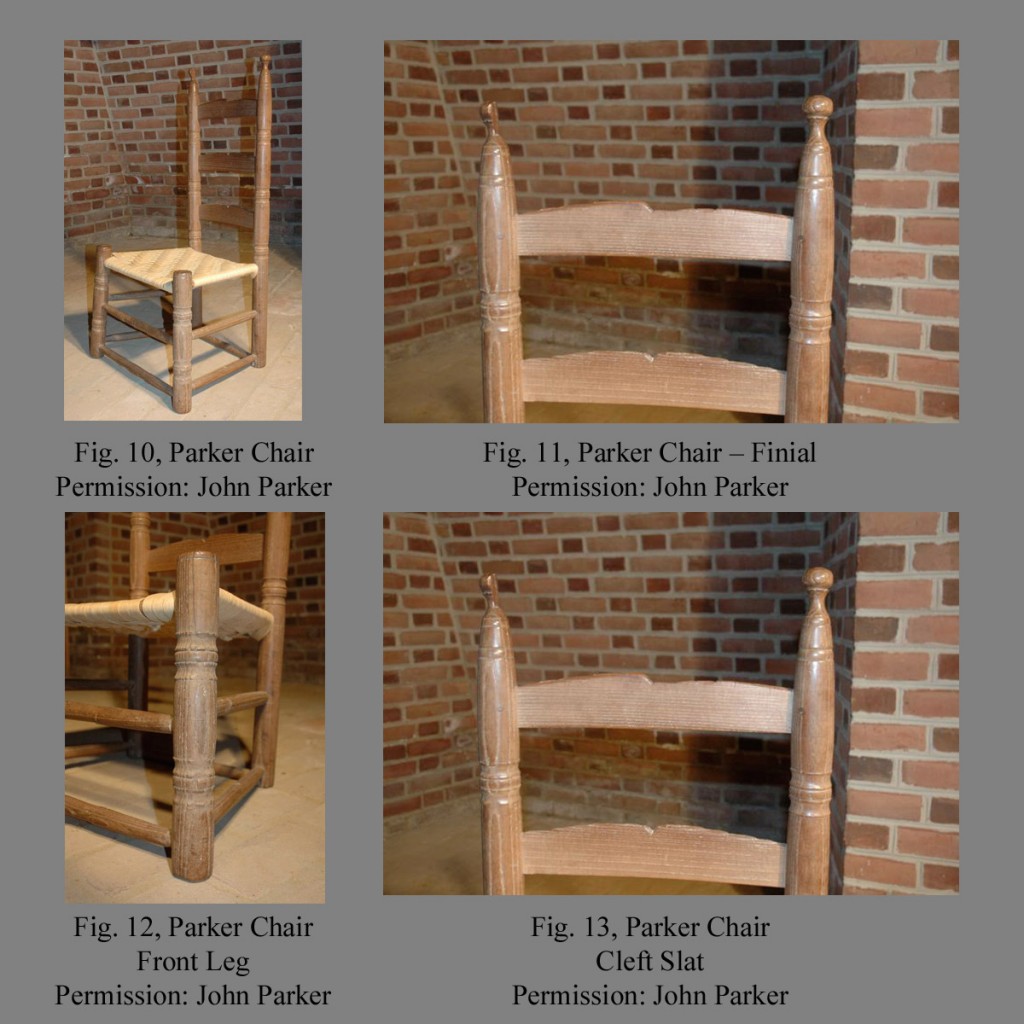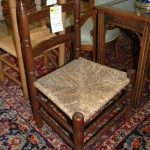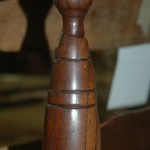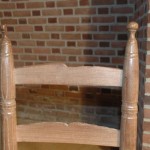From The North Carolina-Virginia Borderland
By Mark R. Wenger
The following essay describes a small group of closely related chairs which originated somewhere in the region between Como, NC and Lawrenceville, Virginia. It is one of more than thirty groupings tentatively identified in an on-going survey of early chairs from the region adjoining the lower Roanoke River and its territories. The chairs from this region are a varied lot. Among many hundreds examined, those shown here are some of the most robustly conceived. All seem to date from the second quarter of the 19th century.
If readers know of other early chairs from this region, especially any for which the history of ownership or recovery is known, the author would be grateful to hear about them, via this website.
These chairs are easily identified by the cleft upper edges of the slats, by the vigorously turned legs, and by the three-stage design of the finials. The latter was clearly abstracted from a Brunswick County design, with the same ascending divisions–torus, truncated cone, and “pawn.” Because the pawn figure is relatively small for these chairs, the stile must begin its taper just above the top slat to complete the required transition. As a result, the whole turning presents a distinctive silhouette. Also unusual are the reel-bead-reel turnings on the legs. To date, just five examples of these chairs have been found. They appear in various sizes, but no arm chairs or high chairs have been noted.
Chrysler Chair
This three-slat adult chair, now at the Chrysler Museum, displays the essential characteristics of the group. The orb at the top of the pawn figure is about the same diameter as the base, and it rides on a slender neck. Symmetrical, reel-bead-reel turnings adorn all four legs–two each on the front legs–three each on the rear legs. All of the slats are cleft on their upper edges. The top one is broken, a common defect on these chairs. The front stretchers each have a rebated turning that swells toward an incised medial bead. Beyond the tapered ends of this turning, the stretcher maintains a constant diameter. A single rear stretcher stands lower than the corresponding side stretchers. Neither the stretchers nor the seat lists interlock. Unfortunately, the feet are partly cut away, but the remaining stumps suggest that the originals had a “quirked” ogee profile.
Mulberry Youth Chair
This scaled-down, “two-back” chair is a youth-sized variation of the cleft-slat design. It is made of mulberry, a material often associated with North Carolina chairs. It displays essentially the same turnings as the previous chair–including the front stretchers. It has been heavily repaired, and the seat is a modern replacement. It was purchased at auction in Boydton, Virginia.
Parker Chair
The chair illustrated here, property of John Parker, displays turnings quite similar to those of the two preceding examples. However, the finial is modeled more robustly than on the other examples, the orb and reel being rendered as separate elements. Note also the rounder modeling of the incised bead below this finial. The top of each front leg is set off by a deeply incised line. The front stretchers resemble those to the two previous chairs.
This example appears to be made of ash. It is the only cleft-slat chair for which a collection history is reported. According to Parker, it came out of an early house at Como, in Hertford County, North Carolina.
Spring Hope Chair
Parker’s chair relates to a fourth example, this one purchased from a dealer in Spring Hope, North Carolina. This chair, made of walnut, is clearly associated with the group, but it differs in three significant aspects.
First, the ornamental leg turnings are broader and flatter than on the examples above. Second, the front legs display a perceptible, upward-taper. Third, unlike the other chairs, this one has a single front stretcher, adorned with an incised medial bead only. All of these distinctions suggest that this chair came from somewhere other than Como.
Sadly, the chair has lost its feet, and the remains are insufficient to offer a complete idea of their original shape. In fact, none of the chairs in this group have their original feet. Characterizing these feet will be the subject of continuing search and study.
Child’s Chair
This child’s side chair is much the worse for wear–the seat and the proper right stile are modern replacements. Nonetheless, it demonstrates the range of forms covered by this group. The leg turnings are rendered very broadly, as on the Spring Hope chair. Like some Virginia and many more North Carolina chairs, this one is made of Mulberry. The slats might have been replaced, which could explain the absence of cleft upper edges. Just above the seat, the original proper left stile is adorned with an incised bead, an ornament seen on no other chair in the group.
This chair came to auction in Suffolk at the sale of a Franklin, Virginia estate.
We have seen that the typical finial of the cleft-slat group is an abstracted version of the classic Brunswick County, VA design (see Fig. 3). Simpler still is the version found on a side chair that descended in the Neblett family of Lawrenceville, the county seat of Brunswick. Though it displays none of the incised ornament seen on the previous examples, the silhouettes seem related. Also, compare this Lawrenceville side-chair finial with the Mulberry Youth Chair and Parker Chair finials (see Figs. 7 & 11). This comparison buttresses the argument for a Brunswick County association.
 Fig. 19, Lawrenceville Side Chair – Finial
Fig. 19, Lawrenceville Side Chair – Finial
Further supporting the Brunswick connection is a mid-nineteenth-century chair now in the office of the county’s Commissioner of Revenue. The slats of this chair are crudely notched in a manner resembling the Meherrin cleft-slat chairs. However, the compressed height of the chair back is a feature observed on certain chairs from Northampton and Bertie Counties, in North Carolina, and it was noted earlier, that the only chair with a documented collection history turned up “next door” in Hertford County.
 Fig. 20, Brunswick County Commissioner of Revenue Side Chair
Fig. 20, Brunswick County Commissioner of Revenue Side Chair
Apparently, cleft-slat chairs of the sort shown here appeared in various manifestations across the region between Como, North Carolina and Lawrenceville, Virginia, essentially the north bank of the Meherrin River. The movement of goods and ideas up and down this watercourse may explain the wide distribution of cleft-slat chairs and related forms. More examples will be needed to pin down their origin more precisely.
That origin is a consequential matter–the embellished stretchers of the first three chairs relate directly to those of an early rocker offered some years ago by New York dealer Leigh Keno. The parallel suggests a more easterly origin for the rocker than previously supposed, but that is another story.
To view a slideshow of all of the photos mentioned in this article, click on one of the following pictures:
Published on: Dec 11, 2012
About the Author: Mark Wenger is employed with Mesick Cohen Wilson Baker, Architects—Albany, New York and Williamsburg, Virginia. The firm specializes in the restoration of Historic buildings. From 1980 to 2003, Wenger worked as an architectural historian with the Colonial Williamsburg Foundation, and makes his home is Williamsburg. He has published two books and a number of articles on architectural subjects.

























